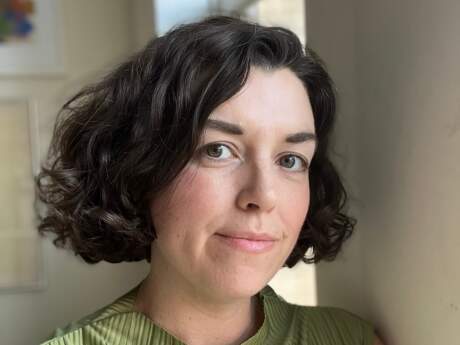In Their Own Words
Sylvia Legris On “A Skull Sectioned, c. 1489”

A Skull Sectioned, c.1489
Each frail luminous globe takes flight...
—Baudelaire
Saw off the barbaric ice, the medieval glacial morbidity.
Nip the postmortem mid-whiff 'midst cold slab, metal, the drifting snow of discover and unearth. Midwinter the cut-time.
Da capo, da capo. From the head a deceptive cadence. Trip the tempo'd trepanum, the singing bone saw, the ink drawn fantastic
through ductus nasolacrimalis, through the paranasal sinuses, through a well-chosen cross-section of foramen mentale.
Then cut across the canalis mandibulae in the moments it takes to murmur a Miserere. Have mercy
on the little city. The merciful cadaver. The bony cittadella.
From The Hideous Hidden (New Directions, 2016). All rights reserved. Reprinted courtesy of the author.
On "A Skull Sectioned, c. 1489"
"A Skull Sectioned," one of a series of poems in The Hideous Hidden written in response to Leonardo da Vinci's anatomical drawings and notebooks, is in the second section of the book, "Midwinter the Cut-time." During the Renaissance, dissections or studies of cadavers were conducted during cold weather—and quickly. Without refrigeration a body decomposed almost faster than it could be cut into.
It's impossible for me to talk about how this single poem came into being in isolation from the other "da Vinci" poems, perhaps even in isolation from the entire collection. The da Vinci drawings are remarkable, not merely for how exquisitely rendered they are as works of art, but for how accurate—if not prescient—da Vinci's representations and observations of human anatomy were. While it's debatable whether da Vinci intended his anatomical studies to be anything other than a means of advancing his own understanding of the human body, what I find compelling about his drawings is that they straddle what is an often fine line between artistic and scientific depiction. These drawings blur the line between clinical objectivity and the subjective eye of the aesthete.
Over the last several years, I've had a range of reactions from people (writers and non-writers) when they've found out I've been working on poems that focus on such morbidly non-poetic things as cadavers and dissection, glands and skin diseases—the gamut from outright dismissiveness to the skeptical "Uh-huh" (at which point they sheepishly slink away) to the "Well, good luck with that." When some of these same people have read or heard me read the poems, they've been invariably surprised at their musicality, their playfulness, that the "ickiness" of the material is counterbalanced by lyrically verdant and historically rich language.
My poems in The Hideous Hidden are preoccupied with the narrow division between what we deem desirable and what repulses us; the paradox of the ugly-beautiful. As with the other poems in this collection, my intention with "A Skull Sectioned" is to unearth or disinter the music inherent in the grotesque; to exhume a language hidden-within-the-hideous, the aim being to expose the concurrent beauty and horror of what Oliver Wendell Holmes termed the pathological sublime—"the tempo'd trepanum, the singing bone saw..."



